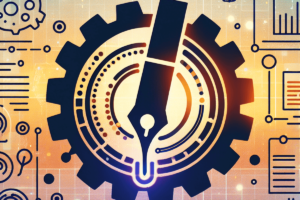The rise of AI tools is transforming how individuals and businesses operate.
These tools are designed to streamline tasks, boost productivity, and improve efficiency across various sectors.
From creating realistic voices and engaging videos to automating operations in small businesses, AI is paving the way for a more technologically advanced world.

Many AI tools, like Murf.ai, generate realistic voiceovers, while others, such as Synthesia, offer video creation options that enhance marketing and sales efforts.
With AI’s expanding role, businesses are finding innovative ways to integrate these tools into everyday workflows, leading to improved communication and collaboration.
AI’s influence continues to spread across content creation and media, offering flexible solutions for creators in various fields.
This technology’s growth reflects broader changes in society’s interaction with tools that offer speed and adaptability. As AI tools continue to evolve, they present new opportunities and challenges, highlighting the importance of responsible use and ethical considerations.
Key Takeaways
- AI tools enhance productivity and efficiency.
- Businesses are integrating AI into daily operations.
- Responsible and ethical AI use is crucial.
Fundamentals of AI Tools

AI tools are revolutionizing the way tasks are automated and data is analyzed.
To fully grasp these technologies, one must understand machine learning, neural networks, and key AI models.
Understanding AI and Machine Learning
Artificial Intelligence (AI) mimics human intelligence to perform tasks, often relying on machine learning, a subset of AI.
Machine learning involves algorithms that allow machines to learn patterns from data. It empowers systems to improve their performance over time without specific programming for every task.
Two popular approaches in machine learning are supervised and unsupervised learning. Supervised learning uses labeled data to train models, while unsupervised learning seeks patterns in unlabeled data.
As AI continues to grow, its applications expand in fields like healthcare, finance, and even gaming, offering more efficient ways of problem-solving.
The Role of Neural Networks and TensorFlow
Neural networks are structures inspired by the human brain. They are pivotal in processing complex data inputs. Each neuron in these networks is responsible for a small computation, and together, they solve intricate tasks.
Various layers in a network, like input, hidden, and output layers, collaborate to analyze data.
TensorFlow is a leading framework in this domain. Developed by Google, TensorFlow supports developers in building and training neural network models. It offers flexibility and robust capabilities, enabling the creation of highly sophisticated networks.
TensorFlow is crucial for handling computational tasks, making it easier for developers to deploy AI models for practical uses.
Key AI Technologies and Models
Technologies such as natural language processing (NLP) and computer vision are at the forefront of AI innovation.
NLP allows machines to understand and interpret human language, which is essential for applications like chatbots and voice assistants.
Computer vision enables machines to identify and process images.
Different AI models, like convolutional neural networks (CNNs) for image processing and recurrent neural networks (RNNs) for sequential data, drive advancements in these technologies. These models are designed to specialize in tasks requiring nuanced understanding of visual or textual data, pushing the boundaries of what AI can achieve.
AI Tools in Business and Productivity

AI tools are revolutionizing how businesses handle customer interactions and streamline operations. They automate repetitive tasks, enhance customer relations, and improve efficiency, making them indispensable for modern businesses seeking to optimize productivity.
Automating Customer Service
AI tools are transforming customer service by automating responses to common inquiries, freeing up human agents for complex issues.
Tools like chatbots and virtual assistants can answer questions and provide support 24/7. This results in faster response times and improved customer satisfaction.
Businesses use AI to analyze data from interactions, finding insights to enhance service offerings. Sentiment analysis helps companies understand customer emotions, enabling personalized experiences.
By using AI tools for customer service, companies reduce costs while increasing efficiency and customer engagement.
Enhancing Sales and CRM with AI
By integrating AI into Customer Relationship Management (CRM) systems, businesses can optimize sales strategies.
Platforms like Salesforce use AI to predict customer behavior, segment audiences, and offer personalized engagement. AI analyzes past interactions and sales data, giving sales teams actionable insights.
Predictive analytics help identify potential leads and prioritize them based on their likelihood to convert. This leads to a more targeted approach and increases the success rate.
AI tools also automate routine tasks such as data entry, allowing sales teams to focus on building relationships with clients, boosting overall productivity.
AI for Project Management and Scheduling
AI is enhancing project management by offering smart scheduling solutions that adapt to changing priorities and resource availability.
AI tools can identify patterns and offer recommendations for optimal resource allocation.
Automated scheduling systems consider deadlines, employee workloads, and project requirements to create balanced and efficient schedules. AI platforms track progress and provide real-time feedback, helping managers make informed decisions.
They also generate reports and forecasts, aiding in risk management and future planning. Through AI, businesses streamline project workflows and improve team collaboration, ultimately enhancing productivity and successful project delivery.
AI-Powered Communication and Collaboration

AI technology is revolutionizing how people communicate and collaborate by making tasks more efficient and interactions smoother. With the integration of chatbots, virtual assistants, AI-driven chat applications, transcription services, and enhanced collaboration tools, teams can now manage tasks and communicate more effectively.
Chatbots and Virtual Assistants
Chatbots and virtual assistants have changed how teams interact with technology and receive support. These tools handle routine inquiries and help users navigate systems more efficiently.
Chatbots can be embedded in websites and applications to provide instant responses, reducing wait times for users.
Virtual assistants like Siri and Google Assistant help users organize schedules, set reminders, and search for information hands-free. These technologies support customers and streamline internal processes, allowing team members to focus on strategic tasks.
AI in Chat Applications and Transcription
AI integration in chat applications has improved communication by providing features like language translation and chat summarization. These capabilities help break down language barriers and ensure that conversations remain concise and meaningful.
Transcription services powered by AI convert spoken language into text quickly and accurately. This transformation is essential for creating records of meetings and interviews.
By simplifying note-taking and documentation, teams can focus on active participation without being distracted by manual transcription tasks.
Collaboration Tools Enhanced by AI
Tools like ClickUp and Trello integrate AI to enhance project management. They organize tasks, automate workflows, and provide insights through data analysis.
AI can predict project timelines and suggest resource allocation, which increases efficiency by reducing bottlenecks.
AI also assists with task prioritization by analyzing past patterns and performance metrics. By helping users focus on high-impact activities, AI-driven tools make collaboration more structured and focused. These innovations ensure that team efforts are aligned with organizational goals and that projects progress smoothly.
AI in Content Creation and Media

AI has reshaped content creation and media by making tasks like writing, image and video creation, and audio processing more efficient. This technology enables creators to produce high-quality work quickly using models like GPT-3 and tools such as DALL-E and Descript.
Generative AI for Writing and Copywriting
Generative AI tools, such as GPT-3 and Jasper, have transformed writing and copywriting. These tools can produce drafts, create SEO-optimized content, and even generate creative storylines.
They assist users by suggesting language improvements, grammar corrections, and enhancing readability with platforms like Grammarly.
AI provides personalized content suggestions tailored to user preferences. This allows writers to focus more on creative aspects by automating repetitive tasks.
AI-Driven Image and Video Creation
AI technologies such as DALL-E, DALL-E 2, and Midjourney are making notable advancements in image generation. These tools create realistic and imaginative images from simple text prompts, broadening creative possibilities.
With AI, artists can experiment with unique styles, colors, and textures effortlessly.
In video creation, platforms like Descript offer advanced editing features. They enable automatic transcription, video and audio editing through text, and seamless syncing. These tools help creators produce high-quality videos faster, making visual content creation more accessible.
Use of AI in Music and Audio Processing
AI is increasingly important in music and audio processing. It helps in composing, remixing, and mastering tracks efficiently.
Tools utilize algorithms to analyze and generate music that aligns with particular genres, moods, or styles.
In audio processing, AI can enhance sound quality, remove noise, and balance different audio elements automatically. This streamlines production, allowing musicians and audio engineers to focus on creativity while maintaining technical quality.
Integrating AI Tools with Existing Workflows

Integrating AI tools into workflows can optimize efficiency by reducing repetitive tasks and enhancing decision-making processes. This section explores how AI apps can be seamlessly incorporated and how automation can transform existing systems for better productivity.
Seamless Integration of AI Apps
AI apps can be integrated into existing workflows by leveraging APIs and cloud computing. APIs allow different software to communicate, making it easier to embed AI functionalities.
For instance, using an API to connect an embedding model with a vector database can enhance data retrieval processes.
Cloud computing provides the necessary infrastructure to support AI tools. It offers scalability and flexibility, enabling businesses to manage AI apps effectively without extensive on-premises equipment.
This allows companies to experiment and prototype with open-source AI tools, ensuring they meet specific business needs before fully integrating them.
Enhancing Workflows with AI Automation
AI automation optimizes workflows by handling repetitive tasks. This allows teams to focus on more complex tasks that require human intervention.
Integration of AI algorithms into workflows can be especially beneficial in processing large volumes of data, making data-driven decisions faster and more accurate.
Artificial Intelligence can be used to analyze patterns and provide actionable insights, enabling smarter decision-making.
Businesses can train their teams to incorporate AI-generated insights into their processes, as seen in a step-by-step guide on AI workflow integration.
Monitoring and gathering feedback after AI integration is key to making necessary adjustments and improvements.
AI and the Evolution of Search Engines

AI technologies are revolutionizing search engines by improving the accuracy of search results and enabling them to understand natural language. These advancements lead to more relevant and precise results for users. Semantic search and Natural Language Processing (NLP) play a crucial role in enhancing user experience and efficiency.
Improving Search with AI Technologies
AI-powered search engines enhance user experience by utilizing advanced algorithms. They analyze and interpret data more effectively.
These technologies enable search engines to predict user intent and provide relevant suggestions. This leads to more efficient query handling and better results.
Some search engines, such as Microsoft Bing, integrate AI without overwhelming users. AI also helps in adapting to algorithm changes, as discussed in Search Engine Land.
By leveraging AI, search engines consistently upgrade their frameworks.
Semantic Search and Natural Language Processing
Semantic search goes beyond keyword matching by considering the context and meaning behind queries. It helps in understanding user intent, making search engines more intuitive.
This allows users to search naturally, using phrases they might use in conversation.
NLP drives this process by interpreting and analyzing human language. It enables search engines to understand complex queries and provide relevant responses.
As highlighted on Unite.ai, deep reasoning skills are essential for handling such challenges.
Through these advancements, search engines become more efficient and user-friendly.
Ethical Implications and Responsible AI

When using AI tools, it’s crucial to consider ethical implications. These include ensuring data privacy and promoting responsible AI practices to mitigate risks and enhance trust.
AI Safety and Data Privacy
AI has the potential to transform industries through data analysis, but it must be done responsibly. Protecting data privacy is essential.
Organizations are tasked with securing user data to prevent breaches and misuse, emphasizing encryption and secure data storage. Regular audits and compliance with privacy laws like GDPR are vital.
Safety in AI systems involves minimizing the risk of biases. Algorithms should be tested for fairness and accuracy.
Implementing transparent processes and involving diverse teams can help identify potential biases early. This ensures that predictive analytics tools behave ethically and make accurate predictions that don’t harm individuals or groups.
Promoting Responsible Use of AI
Responsible AI use involves adopting ethical guidelines across organizations. These guidelines help navigate the complex landscape of AI applications.
Establishing a clear framework for AI development includes principles such as accountability, transparency, and human oversight.
Training staff on AI ethics ensures a well-informed workforce aware of potential risks. This education should focus on understanding the impact of AI decisions on society.
Encouraging collaboration among technologists, ethicists, and industry experts fosters the development of responsible practices.
By prioritizing safety and responsibility, organizations can leverage AI’s power while minimizing potential harm.
Looking Ahead: The Future of AI and AGI

The future of AI promises to reshape our world significantly. Key areas include ongoing advancements in machine learning and the pursuit of Artificial General Intelligence (AGI). These developments aim to create systems that can perform a wide range of tasks with human-like versatility.
Advancements in Machine Learning and AI Research
Recent years have seen AI and machine learning evolve rapidly. Researchers work on improving algorithms to enhance accuracy and efficiency.
Machine learning models are becoming more sophisticated, thanks to increased computing power and large datasets. This progress allows for precise pattern recognition, better natural language processing, and improved decision-making capabilities.
AI is now being integrated into diverse fields, from healthcare to autonomous vehicles. Researchers are focusing on ethical AI, ensuring that these systems remain transparent and unbiased.
Collaborative efforts between tech companies and academic institutions are fostering innovation. Such collaborations speed up finding solutions to complex issues, ultimately enhancing AI’s capabilities.
The Roadmap to Artificial General Intelligence (AGI)
AGI is a highly anticipated goal in AI research. It represents a system that can perform any intellectual task that a human can.
Achieving AGI involves creating machines with learning, reasoning, and problem-solving capabilities like humans. This requires significant advancements in neural architecture and understanding cognitive processes.
Several experts predict that AGI could become a reality in the next decade. The race to AGI involves major tech companies investing heavily in this field.
Researchers are also examining the ethical implications of AGI, considering its potential impact on society. This roadmap highlights a future where machines and humans collaborate more seamlessly, enhancing productivity and creativity.
Frequently Asked Questions

This section explores the key areas where AI tools are making a difference. From aiding content creation to transforming online interactions, AI is reshaping various fields. Learn about effective tools, benefits for students, and more.
What are the top AI tools currently available for content creation?
Several AI tools are popular in content creation. Jasper AI, Rytr, Copy.ai, and Writesonic are widely recognized for their unique features.
Each tool offers different capabilities, making them suitable for various writing needs. These tools are well-regarded for their ability to streamline writing and improve content quality.
How can students benefit from utilizing AI tools in their academic work?
AI tools offer several advantages to students. They can help in organizing research, generating ideas, and even providing grammar checks.
Using these tools, students can improve their writing skills and manage their time efficiently. AI tools also offer assistance in creating structured reports and presentations.
Can AI tools assist in app development, and if so, which ones are recommended?
AI tools can indeed assist in app development. Tools like TensorFlow and IBM Watson provide valuable resources for developers.
They help automate code generation, optimize algorithms, and even offer predictive analytics. These tools are useful for reducing development time and enhancing app functionality.
What features distinguish the most effective AI writing assistants?
Effective AI writing assistants usually have features like grammar and style checking, content suggestions, and tone analysis. They are designed to enhance the clarity and engagement of written content.
Additionally, integration with popular writing platforms and user-friendly interfaces are significant distinguishing factors.
Which free AI tools provide the best functionality without compromising quality?
Free AI tools such as OpenAI’s ChatGPT and Google’s Colab offer substantial functionality. They allow users to explore AI capabilities without significant investments.
These tools balance user-friendliness and quality, providing valuable features for those on a budget while maintaining performance standards.
In what ways have AI tools like ChatGPT transformed user interactions online?
AI tools like ChatGPT have significantly transformed user interactions online. They enable more dynamic and personalized communication. They allow for instant responses and can handle a wide array of queries. This has improved customer service and made information more accessible to users worldwide.















